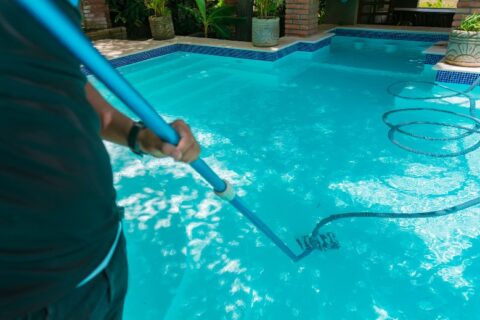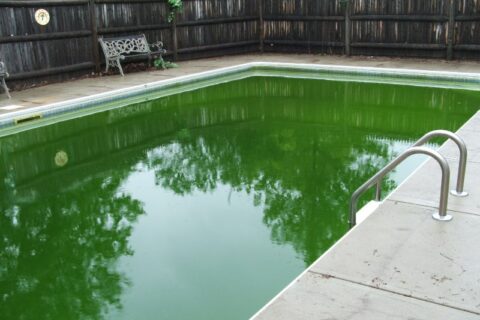How to Treat & Prevent Swimming Pool Algae
Algae blooms are the bane of every swimming pool owner’s existence. If your pool water has started to change colors, don’t ignore this problem. Swimming in and accidentally swallowing algae-infested water can cause skin infections, diarrhea, and other health issues. Follow these tips to manage swimming pool algae successfully.
Treating Different Types of Algae
The three most common strains of algae are easy to identify by their color. Here’s how to treat green, yellow, and black pool algae.
How to Treat Green Pool Algae
- Bring the pH level to 7.2.
- Apply a chlorine enhancer and granular pool shock. If the algae are blooming all over the pool, distribute the granules evenly. If the algae are only in one area, concentrate the shock there.
- Continue to shock the water until it turns a bluish-gray color.
- Scrub the pool thoroughly.
How to Treat Yellow Pool Algae
- Raise the pH to 7.8 and boost the chlorine to 2.0 or 3.0 parts per million (ppm).
- Apply a chlorine enhancer and granular pool shock.
- Scrub the pool, allow the algae to settle to the bottom, and vacuum up the algae debris and shock dust.
- Wash swimsuits, pool toys, floaties, skimmer nets, brushes, vacuum heads, ladders, and light fixtures with hot water and bleach, or replace them entirely.
- Replace or thoroughly clean the pool filter media.
How to Treat Black Pool Algae
- Scrub the “caps” off the algae with a steel-bristled brush to expose the underlying microorganisms to your pool chemicals.
- Apply a chlorine enhancer and shock the pool with a double dose of granular pool shock (one pound per 5,000 gallons).
- Vacuum up the debris.
- Wash all pool accessories with hot water and bleach, or replace them entirely.
- Replace or thoroughly clean the pool filter media.
- Apply a copper-based algaecide after the chlorine level drops below 3.0 ppm, which may take a few days.
Preventing Pool Algae
No matter which type of algae like to grow in your pool, you can prevent blooms with these tips:
- Maintain a chlorine level of 1.0 to 2.0 ppm. Shock the pool when necessary to bring the level up.
- Maintain a pH level of 7.2.
- Scrub the pool weekly.
- Add phosphate removers to eliminate the algae’s primary food source from your pool.
- Apply high-quality algaecide regularly.
- Run your pool pump long enough to filter the water three or four times every 24 hours.
- Improve water circulation in your older pool by adjusting the return fittings to create a different flow pattern.
Working with a swimming pool maintenance expert is the best way to treat and prevent algae. With regular weekly or biweekly visits throughout the summer, you can be confident that your pool is clean, safe, and healthy to swim in. Contact Millennium Pool Service at 703.939.5062 in Virginia or 301.591.3750 in Maryland to learn more about our swimming pool maintenance packages.


